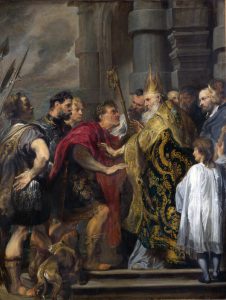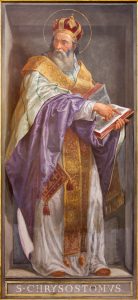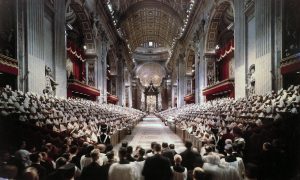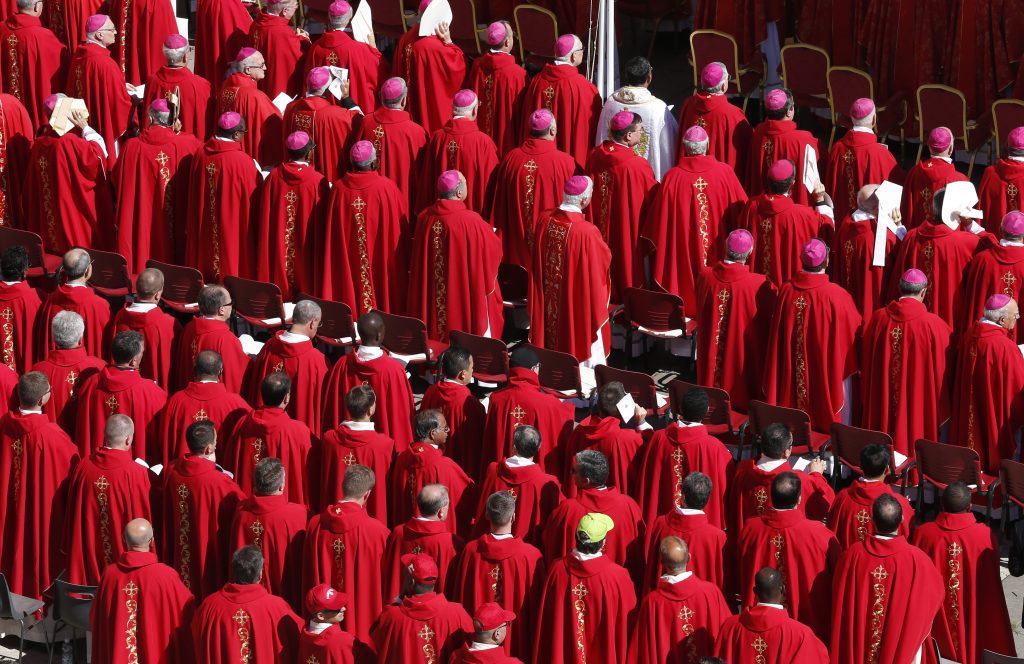If you believe movies like “The Da Vinci Code,” Constantine the Great arrived to the throne as history’s greatest bully. He took power in A.D. 312, and (according to this narrative) he forcefully imposed the Catholic faith on his subjects. He closed up the pagan temples — so the story goes — and turned their keys over to the Catholic bishops.
This story line is, unfortunately, not only a plot device in B movies. It is believed and assumed by people in the media and even in academia.
The problem is that there’s no truth to it.
Constantine could be a bully, yes. He had his wife and son killed in gruesome ways because he feared they were plotting against him.
Constantine could be a thug, as all the Roman emperors were thugs. But he was not a religious bigot.
Though he clearly had made his personal choice for Christianity, he repeatedly made pleas for mutual tolerance between Christians and pagans.
In his Edict to the Eastern Provincials he wrote: “Let those who delight in error alike with those who believe partake of the advantages of peace. ... Let no one disturb another, let each man hold fast to that which his soul wishes. ... What each man has adopted as his persuasion, let him do no harm with this to another.” Constantine condemned “violent opposition to wicked error.”
Constantine was convinced that we could all get along — and he was as likely to enforce mutual respect as Christian orthodoxy.
The problems came with his successors, who were far more willing to take sides in religious disputes. Constantine’s sons did not hesitate to show preference in the Arian controversy. Constantine’s nephew, Julian the Apostate, tried mightily to restore the old, pagan religious order to the entire empire — and he almost succeeded.
But it was Theodosius the Great, who ruled from A.D. 379, who did the deeds for which Constantine usually gets blamed.
It was Theodosius who ended the government subsidy of the pagan temples. It was Theodosius who enacted laws against fortune-telling, witchcraft, and polytheism. And it was he who put an end to the ancient Olympic games, because they were dedicated to the gods of Greece.
The Christian bishops, for their part, welcomed every intervention of Theodosius in religious matters. They were tired of the long struggle for advantage. They knew, moreover, that the old religion would likely collapse and vanish without government subsidy. It had survived so long only because its funding was guaranteed.
The bishops were right about this. Without help from the imperial treasury, the traditional Greco-Roman religion soon withered away.
And Christianity prospered — at least materially — as the government shifted its largesse away from the old temples and into the subsidy of the Christian Church.
The question is whether this was good for Christianity.
The question is not new. Keen observers like St. Augustine in North Africa and St. John Chrysostom in the Middle East noted with horror that the religious establishment had created some unintended side effects, and these were deadly for the spiritual life.
In the time of persecution — then almost a century in the past — it had been a hard thing to be a Christian. To practice the faith was a capital crime. Every believer was at risk. But clergy and laity were in it together, and the rolls of the martyrs bear this out.
Among the victims of the Diocletian persecution are stonecutters, physicians, actors, soldiers, and civil servants, along with the occasional priest, deacon, and bishop. As clergy and laity shared equally in the hardship and humiliation, they shared equally in God’s glory.
Such was the dynamic in a persecuted Church.
But a favored Church — a funded Church — can become something very different.

It’s at least arguable that Theodosius — though he had the best intentions — did something that was very bad for Christianity. He inadvertently invented clericalism.
The new government subsidy was administered mostly by bishops and their clergy. It changed civilization forever, as millions of sesterces were poured into the building of hospitals and churches. The hospital was an institution that had never existed in the pre-Christian world. Now hospitals were everywhere. They were fully funded, and they were usually staffed by monks and nuns.
Times had changed for the clergy and ascetics. Once they had been vilified by the government and shamed in their public deaths. Now they had respect, prestige, and esteem. They controlled the strings on a substantial purse that never seemed to go empty.
Augustine’s modern biographer Peter Brown speaks of a “widening gulf” between the clergy and “a passive rank and file” — the laity.
Increasingly, religion was seen as something the clergy got paid to do. Ordinary people might go to Mass on Sunday and confession once a year, but that would be the extent of their efforts.
“The tendency,” Brown explains, “was to be content with a vicarious holiness by isolating and admiring a recognizable caste of ‘holy’ men and women, who lived a life, the demands of which were conceived of as so superhuman as to be safely unrelated to one’s own life as a man of the world.”
The laity paid their tithe — and furthermore paid taxes to the empire, which then channeled funding to the Church. So what were they paying for if not vicarious holiness?
This first flush of clericalism was a tacit agreement eagerly embraced by both the men in the sanctuary and the families in the pews. That, more or less, is the arrangement the Church settled into after Theodosius.
It wasn’t accepted by all. Augustine opposed it vehemently. But the great crusader against this two-tiered spirituality was John. First a deacon in Antioch and later the bishop of Constantinople, John can hardly be cast as an anti-clerical revolutionary. He wrote the earliest surviving treatise on the priesthood. And he was himself an exemplary cleric, who was not shy about using his rightful spiritual authority.
But one way he used it was by urging the laity to seize their own authority — to take initiative in the spiritual life — to struggle and never to settle for mediocrity. He berated his congregations for being passive.
In one homily he called his people to a high degree of virtue, and then he anticipated the objections of the men in his audience: “You say to me, ‘Look, I’m not one of the monks. I have a wife and children, and I support a household.’ ”
But he replied, “Why, this has been the ruin of us all! You think that the word of the divine Scriptures concerns only [the monks] — when you need it much more than they. For those who dwell in the world are wounded every day, and so have the greatest need of medicines.”
Elsewhere he lamented, “Why, it is just this that makes me sigh — that you think that monks are the only persons properly concerned with decency and chastity. And yet surely Christ made his laws common to all.”
In the strongest terms, John assured his congregation that their calling was nothing less than perfection. He said, “If the beatitudes were spoken only to solitaries, and the secular person cannot fulfill them, yet [Jesus] permitted marriage anyway — then all things have perished, and Christian virtue is boxed in.”
But that could not be the case. And so he continued: “If persons have been hindered by their marriage state, let them know that marriage is not the hindrance, but rather their intentions, which made an ill use of marriage.”
John told his hearers that their jobs and marriages were not obstacles to holiness. Virtue was not somebody else’s job. It’s everybody’s calling.
In a funny passage he imagines a dialogue between a pagan and a Christian. The pagan asks earnestly, “How can I know that God’s commands are feasible? For you were born of Christian parents, and you’ve been brought up in this fine religion, but you don’t do anything of the kind.”
And the Christian replies: “Look, I’ll show you others who do — I’ll show you monks who live in the deserts.”
But, of course, the pagan is unimpressed: “Why should I need to go to the mountains or hunt in the deserts?” Christianity must be a weak religion, he says, if it can’t make him holy in a city or at home.
John did not consider his dialogue to be far-fetched. In fact, he assumed that most of the people in his congregation were guilty of leaving holiness to the monks. He told them that they and he together should “hang down our heads and be ashamed.”
An indifferent disciple is not a disciple, he said. And he quoted Jesus: “Let your light shine before men — not mountains, and deserts, and wildernesses, and out-of-the-way places.”
He insisted that he meant no disrespect to the solitaries and monks in the mountains. He was, rather, bewailing those in the cities. “I beg you,” he said, “let us introduce the discipline they have there here also, that the cities may become cities indeed. This will improve the pagan. This will free him from countless offenses. And so if you would set him free from scandal, and yourself enjoy rewards without number, set your own life in order, and make it shine forth upon all sides, that men may see your good works, and glorify your Father who is in heaven.”
Repeatedly, John insisted that the same “regulations are for all … for priests, and monks, and … men of secular occupations.”
The call to holiness goes out not to “the monks only … but every believer … [every] layperson.” Why? Because, he said, it is baptism that “renders a man a brother, and the partaking of the divine mysteries.”

It is baptism that makes saints, not holy orders and not solemn vows. It is baptism that makes equals of clergy and laity, though equals with very distinct roles.
In the time of persecution this had been clear to everyone. The Church was everybody’s business.
In the time of establishment, however, it was increasingly otherwise. Religion was like entertainment — something to be vicariously enjoyed, from a distance. Or it was like sewer service — something that citizens paid other people to maintain.
Laypeople might take pride in it, as citizens take pride in their public library. They might rely on it for comfort in hard times and at the hour of death. But, for the most part, they were content to leave Christian living to the priests.
That was the great sorrow of John, Augustine, and other saints. But it was now the status quo, and it would remain so for centuries.
It’s at least arguable that this two-tiered spirituality remains the status quo even today, though God is doing the best he can to change it.
Some 60 years ago, St. Pope Paul VI led the bishops of the world as they met for the Second Vatican Council. As pope, he stood as the council’s definitive interpreter, and he said without hesitation that “the most characteristic and ultimate purpose of the teachings of the Council” was the “universal call to holiness.”
The council and the pope spoke with one voice as they reminded the Church of this original doctrine of Jesus. The Savior looked out on a vast crowd as he said, “Be perfect as your heavenly Father is perfect” (Matthew 5:48). The crowd included some who were disciples, who had given up everything to follow the Master. But those were a small minority. An even tinier minority were the Twelve, the chosen apostles, who would be the first clergy in the Church.
Yet all the crowd received the vocation to holiness, which is universal. Only saints will enter heaven. And Jesus called everyone in the crowd to enter heaven, to be a saint.
To live in heaven at the end of life, a saint must begin to live in a heavenly way on earth.
This was the firm belief of Pope Paul. In 1968 he issued the encyclical “Humanae Vitae” (“On Human Life”), in which he affirmed the Church’s constant teaching against abortion and contraception.
We now know that he upheld the doctrine against the wishes of most of his advisers. He recognized a subtle form of clericalism in their arguments. They were telling him that the great life isn’t really intended for the laity. It’s just for the elite, the ordained.

Almost 60 years have passed since the council, and still some people promote this clericalism of low expectations. But it’s getting harder to sustain.
Once upon a time the Church had so many priests it hardly knew what to do with them.
Recent events, however, have reduced the numbers of the clergy — and the prestige and trust associated with the office. Charitable giving to parishes has plummeted. Cherished institutions are closing.
Clericalism will go, one way or another. That seems to be the will of God. It seems also to be an urgent concern of Pope Francis. Indeed, no pope — in all the history of the Church — has so frequently and passionately denounced clericalism in his preaching.
In a 2016 letter he wrote that “Clericalism ... gradually extinguishes the prophetic flame to which the entire Church is called to bear witness in the heart of her peoples.”
In an interview shortly before he became pope, he called clericalism a “disease.” He railed against priests whose only way of showing respect for the laity was by making them more like clergy.
He said, “We priests tend to clericalize the laity. We do not realize it, but it is as if we infect them with our own disease. And the laity — not all, but many — ask us on their knees to clericalize them, because it is more comfortable to be an altar server than the protagonist of a lay path. We cannot fall into that trap — it is a sinful complicity.”
With such strong language, the pope makes clear that the Christian future will be post-clericalist or it will not be at all.
This does not mean the Church will go forward without clergy. But it means that more and more parishes may begin to look healthier from back to front.
In a post-clericalist Church, there will be no more silent complicity between clergy and laity. There will be no mutual enabling in mediocrity.
There will be clergy and laity who take up the hard disciplines of Christian prayer … and hold one another accountable.
There will be clergy and laity who lean into the moral demands of Christian life … and hold one another accountable.
There will be clergy and laity who share responsibility not only for the upkeep of the grounds, but for the evangelization of the community.

